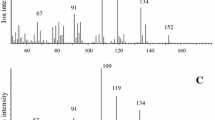Abstract
Hyssop (Hyssopus officinalis) produces an essential oil containing the saturated bicyclic monoterpene ketones pinocamphone and isopinocamphone, with lesser amounts of myrtenol derivatives. A microsomal preparation from leaf epidermis oil glands of this species converts the parent olefin (-)-β -pinene to the allylic alcohol (+)-trans-pinocarveol that presumably gives rise to (-)-pinocamphone and (-)-isopinocamphone by subsequent oxidation and two stereochemical alternatives for reduction of the conjugated double bond. The same preparation catalyzes the hydroxylation of (-)-α-pinene to (-)-myrtenol at a slower rate. The pinene hydroxylase from the oil glands Hyssop has characteristics of a distinct cytochrome P-450 species, yet shares properties with other monoterpene olefin P-450 hydroxylases from the oil glands of several essential oil-producing plants. These results with pinane-type monoterpenes extend the observation that parent cyclic olefins are metabolized by a pathway involving allylic oxidation and conjugate reduction.
Access this chapter
Tax calculation will be finalised at checkout
Purchases are for personal use only
Preview
Unable to display preview. Download preview PDF.
Similar content being viewed by others
Literature
R. Croteau, Biosynthesis and Catabolism of Monoterpenoids, Chem. Rev. 87:929 (1987).
R. Croteau, Biochemistry of Monoterpenes and Sesquiterpenes of the Essential Oils,in: “Herbs, Spices and Medicinal Plants -Recent Advances in Botany, Horticulture and Pharmacology,” Vol. 1, L. E. Craker and J. E. Simon, eds., Oryx Press, Phoenix (1986).
F. Karp, J. L. Harris, and R. Croteau, Metabolism of Monoterpenes: Demonstration of the Hydroxylation of (+)-Sabinene to (+)-cw-Sabinol by an Enzyme Preparation from Sage (Salvia ojficinalis) Leaves, Arch. Biochem. Biophys. 256:179 (1987).
F. Karp, C. A. Mihaliak, J. L. Harris, and R. Croteau, Monoterpene Biosynthesis:Specificity of the Hydroxylations of (-)-Limonene by Enzyme Preparations from Peppermint (Mentha piperita) ,Spearmint (Mentha spicata) ,and Perilla (Perillafrutescens) Leaves, Arch. Biochem. Biophys. 276:219 (1990).
J. Gershenzon, D. McCaskill, J. Rajaonarivony, C. Mihaliak, F. Karp, and R.Croteau, Biosynthetic Methods for Plant Natural Products: New Procedures for the Study of Glandular Trichome Constituents, Recent Adv. Phytochem. 25:347 (1991).
R. Croteau, C. L. Hooper, and M. Felton, Biosynthesis of Monoterpenes: Partial Purification and Characterization of a Bicyclic Monoterpenol Dehydrogenase from Sage (Salvia officinalis), Arch. Biochem. Biophys. 188:182 (1978).
R. Croteau and M. Felton, Substrate Specificity of Monoterpenol Dehydrogenases from Foeniculwn vulgare and Tanacetum vulgare ,Phytochemistry 19:1343 (1980).
R. Kjonaas, C. Martinkus-Taylor, and R. Croteau, Metabolism of monoterpenes: Conversion of /-Menthone to l-Menthol and d-Neomenthol by Stereospecifìc Dehydrogenases from Peppermint (Mentha piperita) Leaves, Plant Physiol. 69:1013 (1982).
R. B. Kjonaas, K. V. Venkatachalem, and R. Croteau, Metabolism of Monoterpenes: Oxidation of Isopiperitenol to Isopiperitenone, and Subsequent Isomerization to Piperitenone, by Soluble Enzyme Preparations from Peppermint (Mentha piperita) Leaves, Arch. Biochem. Biophys. 238:49 (1985).
R. Croteau and K. V. Kenkatachalam, Metabolism of Monoterpenes: Demonstration that (+)-cw-Isopulegone, not Piperitenone, is the Key Intermediate in the Conversion of (-)-Isopiperitenone to (+)-Pulegone in Peppermint (Mentha piperita), Arch. Biochem. Biophys. 249:306 (1986).
B. M. Lawrence, Progress in Essential Oils, Perfumer and Flavorist 9:38 (1984).
O. H. Lowry, N. J. Rosebrough, A. L. Farr, and R. J. Randall, Protein Measurement with Folin Phenol Reagent, J. Bid. Chem. 193:265 (1951).
T. Omura and R. Sato, The Carbon Monoxide-Binding Pigment of Liver Microsomes, J. Bid. Chem. 239:2379 (1964).
R. Croteau and M. A. Johnson, Biosynthesis of Terpenoids in Glandular Trichomes, in: “Biology and Chemistry of Plant Trichomes,” E. Rodriguez, P. L. Healy, and I. Mehta, eds., Plenum, New York (1984).
J. T. Groves and D. V. Subramanian, Hydroxylation by Cytochrome P-450 and Metalloporphyrin Models. Evidence for Allylic Rearrangement, J. Am. Chem. Soc. 106:2177 (1984).
C. A. West, Hydroxylases, Monooxygenases, and Cytochrome P-450, in: “The Biochemistry of Plants,” Vol. 2, D. D. Davies, ed., Academic, New York (1980).
R. W. Estabrook and J. Werringloer, The Measurement of Difference Spectra:Application to the Cytochromes of Microsomes, in: “Methods in Enzymology,” Vol. 52, S. Fleischer and L. Packer, eds., Academic, New York (1978).
B. Testa and P. Jenner, Inhibitors of Cytochrome P-450s and Their Mechanism of Action, Drug Metab. Rev. 12:1 (1981).
R. C. Coolbaugh, S. S. Hirano, and C. W. West, Studies on the Specificity and Site of Action of α-Cyclopropyl-α-[p-methoxyphenyl]-5-pyrimidine Methyl Alcohol (Ancymidol), a Plant Growth Regulator, Plant Physiol. 62:571 (1978).
Author information
Authors and Affiliations
Editor information
Editors and Affiliations
Rights and permissions
Copyright information
© 1992 Springer Science+Business Media New York
About this chapter
Cite this chapter
Karp, F., Croteau, R. (1992). Hydroxylation of (-)-β-Pinene and (-)-α-Pinene by a Cytochrome P-450 System from Hyssop (Hyssopus Officinalis). In: Petroski, R.J., McCormick, S.P. (eds) Secondary-Metabolite Biosynthesis and Metabolism. Environmental Science Research, vol 44. Springer, Boston, MA. https://doi.org/10.1007/978-1-4615-3012-1_17
Download citation
DOI: https://doi.org/10.1007/978-1-4615-3012-1_17
Publisher Name: Springer, Boston, MA
Print ISBN: 978-1-4613-6312-5
Online ISBN: 978-1-4615-3012-1
eBook Packages: Springer Book Archive




